What would your future-you have to say to you?
The no-pants guide to spending, saving, and thriving in the real world.
What would your future-you have to say to you?
I keep calling these lessons, but they are examples and explanations, more than lessons. Names aside, please see Part 1 and Part 2 to catch up. The Google Doc of this example is here.

This time, I’m going to review my non-monthly bills. These are the bills that have to be paid, but not on a monthly basis. Some are annual, others are quarterly, or even weekly. Every month, the amount–adjusted to the monthly equivalent–is set aside in Quicken.
There aren’t too many items here that can be legitimately and responsibly trimmed.
Everybody wants their children to do well. I want my kids to grow up without making my mistakes. Here are a few ways to help them avoid debt.
How do you protect your kids’ future finances from the kids themselves?
I had total diet fail last month.
From April to May, across 4 consecutive weekends, I put a bit over 1500 miles on my car on 4 separate trips. That is something like 10 times my average mileage.
That’s a lot of driving, squeezed around a regular schedule of work. Have you ever tried a drive through for low-carb food? Because of that, and the circumstances of some of my trips, I abandoned my diet on those weekends. Funeral food is rarely low-carb.
By the time those trips were over, I had spent so much time off my diet that “What’s one more sandwich?” became an easy justification. There is a reason I don’t break the rules I give myself. I can’t seem to cheat just once. Once I cross that line, it’s over.
So, instead of cheating on my diet and feeling guilty, I officially dropped it for most of the month of May. I decided it would be easier to get it out of my system than to continue worrying about it.
May’s over, and I’m back on the Slow Carb diet. My little fail cost me 7 pounds and 6.5 total inches(waist , hips, biceps, and thighs). I’m reasonably sure that most of that is water and will evaporate before next weekend.
Best Posts
My goal is to live my life so that I have no regrets at the end of it. That means pursuing my dreams and doing the things I love.
It’s easier to do the things I love when my life isn’t weighed down by the crap I don’t need.
Sweating the Big Stuff wrote a killer post on saving money simply by asking. Often, the easy things work.
Shopping Online: The Money-Saving Secret was included in the Festival of Frugality.
Money Problems: Paying Off Debt was included in the Carnival of Personal Finance.
5 Ways to Help Your Friends Stay Out of Debt was included in the Totally Money Blog Carnival.
Should Pupils Focus on Personal Finance was included in the Yakezie Carnival.
Thank you! If I missed anyone, please let me know.
There are so many ways you can read and interact with this site.
You can subscribe by RSS and get the posts in your favorite news reader. I prefer Google Reader.
You can subscribe by email and get, not only the posts delivered to your inbox, but occasional giveaways and tidbits not available elsewhere.
You can ‘Like’ LRN on Facebook. Facebook gets more use than Google. It can’t hurt to see what you want where you want.
You can follow LRN on Twitter. This comes with some nearly-instant interaction.
You can send me an email, telling me what you liked, what you didn’t like, or what you’d like to see more(or less) of. I promise to reply to any email that isn’t purely spam.
Have a great week!
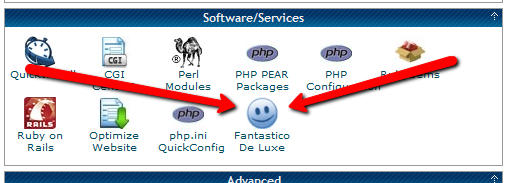
In this installment of the Make Extra Money series, I’m going to show you how to set up a WordPress site. I’m going to show you exactly what settings, plugins, and themes I use. I’m not going to get into writing posts today. That will be next time.
I use WordPress because it makes it easy to develop good-looking sites quickly. You don’t have to know html or any programming. I will be walking through the exact process using Hostgator, but most hosting plans use CPanel, so the instructions will be close. If not, just follow WordPress’s 5 minute installation guide.
Assuming you can follow along with me, log in to your hosting account and find the section of your control panel labeled “Software/Service”. Click “Fantastico De Luxe”.

On the Fantastico screen, click WordPress, then “New Installation”.
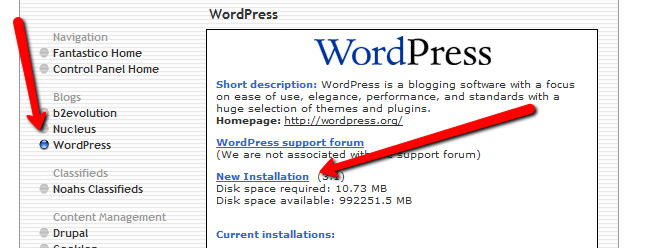
On the next screen, select your domain name, then enter all of the details: admin username, password, site name, and site description. If you’ll remember, I bought the domain http://www.masterweddingplanning.net. I chose the site name of “Master Wedding Planning” and a description of “Everything You Need to Know to Plan Your Wedding”.
Click “install”, then “finish installation”. The final screen will contain a link to the admin page, in this case, masterweddingplanning.net/wp-admin. Go there and log in.
After you log in, if there is a message at the top of the screen telling you to update, do so. Keeping your site updated is the best way to avoid getting hacked. Click “Please update now” then “Update automatically”. Don’t worry about backing up, yet. We haven’t done anything worth saving.
Next, click “Settings” on the left. Under General Settings, put the www in the WordPress and site URLs. Click save, then log back in.
Click Posts, then Categories. Under “Add New Category”, create one called “Misc” and click save.
Click Appearance. This brings you to the themes page. Click “Install Themes” and search for one you like. I normally use Headway, but before I bought that, I used SimpleX almost exclusively. Your goal is to have a simple theme that’s easy to maintain and easy to read. Bells and whistles are a distraction.
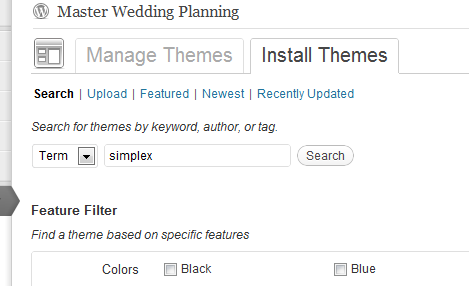
Click “Install”, “Install now”, and “Activate”. You now have a very basic WordPress site.
A plugin is an independent piece of software to make independent bits of WordPress magic happen. To install the perfect set of plugins, click Plugins on the left. Delete “Hello Dolly”, then click “Add new”.
In the search box, enter “plugin central” and click “Search plugins”. Plugin Central should be the first plugin in the list, so click “install”, then “ok”, then “activate plugin”. Congratulations, you’ve just installed your first plugin.
Now, on the left, you’ll see “Plugin Central” under Plugins. Click it. In the Easy Plugin Installation box, copy and paste the following:
All in One SEO Pack Contact Form 7 WordPress Database Backup SEO SearchTerms Tagging 2 WP Super Cache Conditional CAPTCHA for WordPress date exclusion seo WP Policies Pretty Link Lite google xml sitemaps Jetpack by WordPress.com
Click “install”.
On the left, click “Installed Plugins”. On the next screen, click the box next to “Plugins”, then select “Activate” from the dropdown and click apply.
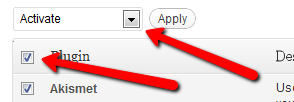
Still under Plugins, click “Akismet Configuration”. Enter your API key and hit “update options”. You probably don’t have one, so click “get your key”.
The only tool I worry about is the backup. It’s super-easy to set up. Click “Tools”, then “Backup”. 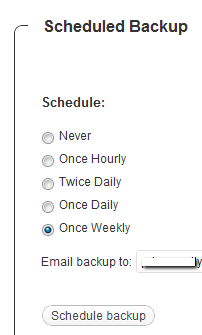
Scroll down to “Schedule Backups”, select weekly, make sure it’s set to a good email address and click “Schedule Backup”. I only save weekly because we won’t be adding daily content. Weekly is safe enough, without filling up your email inbox.
There are a lot of settings we’re going to set. This is going to make the site more usable and help the search engines find your site. We’re going to go right down the list. If you see a section that I don’t mention, it’s because the defaults are good enough.
Set the Default Post Category to “Misc”.
Visit this page and copy the entire list into “Update Service” box. This will make the site ping a few dozen services every time you publish a post. It’s a fast way to get each post indexed by Google.
Click “Save Changes”.
Uncheck everything under “Email me whenever…” and hit save. This lets people submit comments, without actually posting the comments or emailing me when they do so. Every once in a while, I go manually approve the comments, but I don’t make it a priority.
Select “Custom structure” and enter this: /%postname%/
Click save.
Set the status to “Enabled”, then fill out the site title and description. Keep the description to about 160 characters. This is what builds the blurb that shows up by the link when you site shows up in Google’s results.
Check the boxes for “Use categories for META keywords” and “Use noindex for tag archives”.
Click “Update Options”.
Check the boxes to remove each of the dates and set the alt text to “purpose” or something. This will suppress the date so your posts won’t look obsolete.
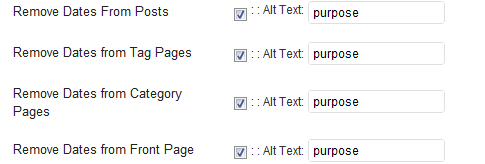
This plugin reinforces the searches that bring people to your site. It’s kind of neat. Skip the registration, accept the defaults and hit save.
Scroll to the bottom and click import. We’ll come back to this.
Select “Caching On” and hit save.
Across the top of the screen should be a giant banner telling you to connect to WordPress.com and set up Jetpack. You’ll need an account on WordPress.com, so go there and set one up. After authorizing the site, you’ll be brought back to the Jetpack configuration screen. Click “Configure” under “WordPress.com Stats”. Take the defaults and hit save.
On the contact configuration page, copy the code in the top section. You’ll need this in a moment.
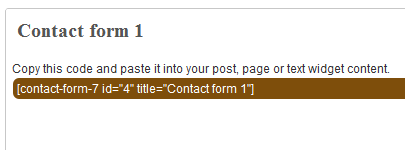
Now, we going to create a couple of static pages. On the left, click “Pages”, then “Add new”.
Name the first page “Contact” and put the contact form code in the body of the page. Hit publish.
Under Appearance, click “Menu”. Enter a menu name and hit save.
Then, under “Pages”, click the box next to “Contact”, “Disclaimer”, and any other policies you’d like to display. Hit save.
Also under Appearance, click “Widgets”. This is where you’ll select what will display in the sidebar. All you have to do is drag the boxes you want from the middle of the page to the widget bar on the right. I recommend Text, Search, Recent Posts, Popular Search Terms and Tag Cloud. In the text box, just put some placeholder text in it, like “Product will go here”. We’ll address this next time.
We’re not going to worry about getting posts in place, yet. That will be the next installment. However, the steps in the next installment could take 2 weeks to implement, and we want Google to start paying attention now. To make that happen, we need to get a little bit of content in place. This won’t be permanent content. It’s only there so Google has something to see when it comes crawling.
To get this temporary, yet legal content, I use eZineArticles. Just go search for something in your niche that doesn’t look too spammy.
Then, click “Posts”, then delete the “Hello World” post. Click “Add new”. Copy the eZine article, being sure to include the author box at the bottom, and hit publish.
To see your changes, you may have to go to Settings, then WP Cache and delete the cache so your site will refresh.
Congratulations! You now have a niche blog with content. It’s not ready to make you any money, yet, but it is ready for Google to start paying attention. In the next installment, I’ll show you how I get real unique content and set it up so Google keeps coming back to show me the love.
Today, I am continuing the series, Money Problems: 30 Days to Perfect Finances. The series will consist of 30 things you can do in one setting to perfect your finances. It’s not a system to magically make your debt disappear. Instead, it is a path to understanding where you are, where you want to be, and–most importantly–how to bridge the gap.
I’m not running the series in 30 consecutive days. That’s not my schedule. Also, I think that talking about the same thing for 30 days straight will bore both of us. Instead, it will run roughly once a week. To make sure you don’t miss a post, please take a moment to subscribe, either by email or rss.
On this, Day 10, we’re going to talk about debt insurance.
Debt insurance is insurance you pay for that will pay your lender in the event of your death, dismemberment, disfigurement, disembowelment, or unemployment. Exactly what is covered varies by insurer, type of debt, and what you are willing to pay for.
Private Mortgage Insurance(PMI) is a common form of debt insurance. Generally, if you take out a mortgage with a down payment under 20%, you’ll be expected to pay for PMI. According to the Homeowners Protection Act of 1998, you have the right to request your PMI be cancelled after reducing your loan amount to 78% of the appraised value of the property. That ensures that the lender will be able to recoup their money by seizing the mortgaged property if you should happen to fall under a bus or get hit by a meteorite.
Another common form of debt insurance is for your credit cards. Card companies love it when you buy their insurance. If you buy their life insurance, your card is paid off when you die. Disability insurance pays it if your get hurt. Unemployment insurance…you get the idea.
Here’s the deal: Get life insurance and disability insurance separately. It’s cheaper than getting it through your credit card company and let’s you get enough to actually live on if something tragic happens. Unless, of course, you die. Then it will leave enough for your heirs to live on.
As far as unemployment insurance, build up your emergency fund instead. That’s money that gives you options. Credit card insurance is money flushed down the toilet. Many of these policies cost 1% of your balance. If you’ve got a $5,000 balance, that will mean you are paying $50 per month. By comparison, if you’ve got a 9.9% interest rate, you’ll be paying about $40 per month in interest.
Debt insurance is a bad idea, if you can possibly avoid it. A combination of life insurance, disability insurance, and an emergency fund provide better protection with more flexibility.
Your task for today is to review your credit card statements and mortgage agreement and see if you are paying debt insurance on any of it. If you are, cancel and set up the proper insurance policies to protect yourself and your family.